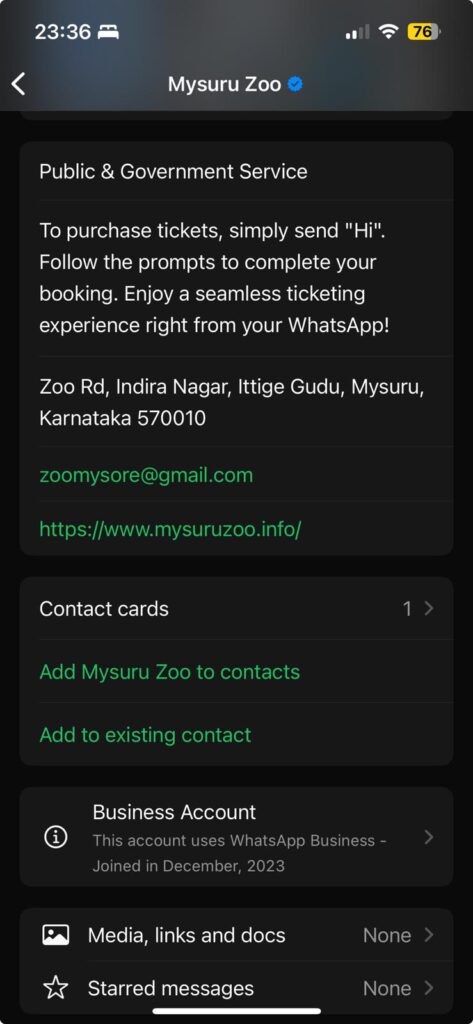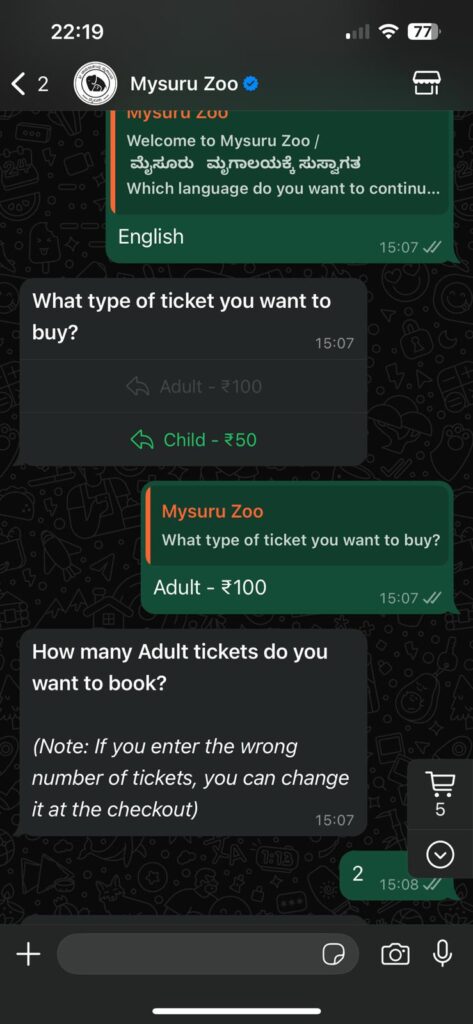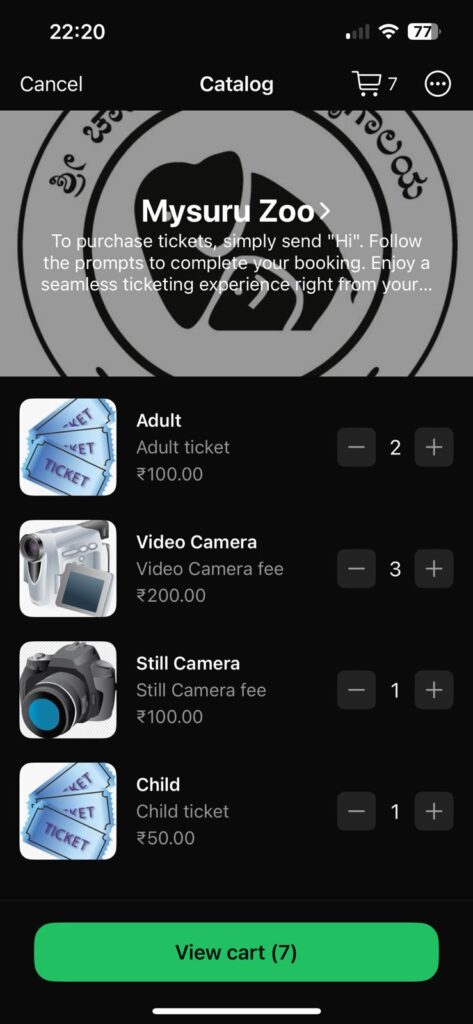


The Growing Power of WhatsApp Business
WhatsApp has been a major platform for communication in the Asian market with over 2 billion users worldwide and 50m plus brands using it for business. India is the number one user of WhatsApp Business.
Recently, there has been an update on WhatsApp Business, where businesses can sell items and services on the platform. There are registered vendors with Meta like AIsensy and Interakt, which are the major players for WhatsApp Business solution providers. These platforms use WhatsApp Business APIs, enabling potential customers to be reached more easily and promoting their products and services.
The registration process is straightforward, as WhatsApp will be linked to the company’s Facebook account. The vendors do an amazing job of helping customers register easily. The whole process is hassle-free, apart from proving that you are a legitimate business owner. With a little bit of quick Googling and ChatGPT, I think anyone can register and start a small business. (I completely stand by this statement.)
When I came to know of such technology and product exits, I shrugged it off as I thought it catered to small businesses only to sell services and for big companies to deliver personalized advertising. Never would I have thought that this would be a game-changer when it comes to ticketing.
A Humble Suggestion That Sparked an Idea
Like my usual weekly routine, I visit the zoo to see if my products are working properly and meet with stakeholders to see that the services that I provide are up to expectations, take feedback, and look for opportunities. After I finish talking to them, I always meet and greet all ground-level staff as I admire their work, and without them, the zoo would not run.
They had grown fond of me as I used to have lunch with them in the canteen and talk about their work and daily routine as I was always looking for opportunities to make their life easy by introducing any modern touch to an age-old job. I am also curious about their way of understanding and how they interact with technology and their perspective. Just jokingly, one of the animal keepers asked, “Since everyone is on their phone, why not send tickets to them on their phone instead of standing in a queue and purchasing paper tickets?”
I said, “Yes, we already have a solution for that; people can book on the website, and without a paper ticket, they can show it on their mobile.” However, his understanding of web-based tickets was that they could be accessed only from a computer. He asked me, “I don’t have a computer for booking tickets. Can you book it for me from my mobile phone?” This request was heartfelt, and I showed him how to book tickets from the web app and mobile app. He found that very cumbersome—entering phone numbers, entering OTP, and checking email for tickets. He just asked, “I have WhatsApp. Can you send the photo of the ticket here instead of email?”
You know in cartoons you see that part where a light bulb appears on top of the head? Let’s just say mine was too bright.
Turning an Idea into Action
I went back to the drawing board and started to do some research. I started to see if the project was going to be viable if there could be any expected profits, and to see what it would cost to serve one customer. Currently, we are spending 0.002 INR per ticket sold if booked from the website; this includes the hosting and maintenance cost, and WhatsApp with AIsensy would cost us 0.001 INR per ticket sold—almost half the cost.
Hosting would be taken care of by AIsensy, and we oversaw maintenance. This was huge. I convinced the stakeholders on the business model, cost of development, time for the zoo to recuperate initial investment, cost analysis, and future volumes we could expect because of its convenience. They were very happy with this and gave the go-ahead for the project. (I wish I could give more info on the business model, but it’s a special circumstance where we have struck an NDA and cannot reveal more than this, but I will tell you about the product journey 😊.)
Building the Future of Ticketing
The CEO of AIsensy was very interested in my idea of using WhatsApp as a platform for selling tickets. The idea was, that we initiate a conversation with the user on what type of tickets they want, and when they are finished with that, we send a payment link to their WhatsApp account, and after payment is done, we send the PDF ticket to their phone.
Now that we all understood what we had to develop, I put in a product roadmap and quickly introduced my engineers to the AIsensy team. We started the product development, finished all the necessary documentation, and the project started for prototype development and beta testing.
After weeks of deliberation, tracking backlogs, assigning tasks, and multiple communications, we had a prototype. It was simple: users scanned a QR code, sent a “Hi” message, and then selected the language in which they wanted to communicate. We had Hindi, English, and Kannada. Then the type of ticket they wanted—like adult or child, how many they wanted, and after the conversation, we sent them the ticket via PDF on the phone after payment.
The prototype was a success, and this took us almost two months to develop. I was quite surprised that we didn’t hit any blockers and had developed it without any issues but was I in for a surprise in the coming days!
Facing the Festival Frenzy
We started the beta testing, and the results were amazing. I had set KPIs on QR scans, payment success, and ticket validation for the test. We had a 72% user conversion rate from traditional paper tickets to WhatsApp-based tickets and 90% completed the booking and getting the tickets.
The zoo was happy, and we finally launched the product with the Forest Minister of Karnataka. We got a lot of traction for this product. Every so often, we used to get users who faced difficulties even here, but with a simple how-to guide, they could understand how the product works. My ideal goal was 100% user adoption, but we did not achieve that.
Then came Dasara, a festival where the zoo gets 4M visitors—yes, in one day. Now we were prepared and knew that our software could handle this. We had tested it in advance and were happy with the results. Now the crowd starts to pick up the whole month.
Just one month before the main festival, we see there is a huge crowd in front of the QR code—people booking tickets and getting the tickets. Even though we had the QR codes at multiple locations, they had gathered like moths to flame. Seeing this, the zoo got worried whether there was any issue with the software, but it was running smoothly. Reality hit us when I realized how long it takes for the conversation, for each ticket to be booked.
Imagine thousands of people standing in groups, some not knowing what conversation to have with the bot, and this was chaos. Tech-savvy people got tickets and moved on, and on top of this, we had issues with the Razorpay payment gateway system throwing payment failure errors randomly.
Right when I thought this couldn’t get worse, here I am in the middle of a sea of people who are facing issues where payments are being deducted but tickets are not generating for some users, some asking for refunds, and some are frustrated (frustrated is an understatement).
Well, I had to go back to the drawing board and figure out what went wrong but had no time to do so. With a heavy heart, I made the decision to halt the system and go with traditional booking, immediately opened 8 extra ticket counters, created counter users, and I remember sitting at one of the counters collecting cash and issuing tickets to visitors, and managing the crowd. And this was not even the day we thought we would expect a crowd.
Reality hit us hard, but our resilience and determination were strong. The next day, I set new KPIs and saw where this all went wrong, the log files—I remember a text document was 23MB. In the new set of KPIs, we saw how many initiated the conversation, on each conversation with the bot, how much time it took to reply, then we started to see where the user started to stop the conversation entirely or if they went to the end and finally got the ticket, how much time it took.
Well, the results were surprising as it took a normal user almost 140 seconds on average to get the ticket. On top of that, there is this crowd psychology: if one person gets it and starts moving, and he arrives after you, you feel that there is something wrong or you are not doing it correctly (Yes, I researched into it to see if there was a different angle to the solution. It’s called “queue anxiety”).
Reimagining the Solution
The next course of action was one step at a time, but I did not have that luxury of time. I had to deliver the project again and leave no space for errors this time.
The first thing I discussed was if there could be an alternate angle to this solution. I was talking to the CEO of AIsensy, and he was also looking for ways to make the process simpler. Then Meta released this shopping cart inside WhatsApp, and it was still new and in the first stages.
I immediately knew that this was the solution to all problems. It’s as simple as clicking plus or minus and just proceeding to pay. We immediately, with special permission to use that function from Meta, implemented it on our business account. We had a small focus group where we tested the product, and the results were perfect. The entire average time it took to book a ticket was 12 seconds.
Now that this is done, what to do with Razorpay payment failures? Again, get logs, raised tickets with them, and had a huge back-and-forth with them, but they were not as enthusiastic as I was about solving the issue. With a heavy heart, I took the option of changing the payment gateway itself. Simple, right? (I feel I can write a separate blog for this.)
Luckily, PhonePe was also new in the payment gateway market and was eager to onboard new customers and made the onboarding process easy, and cherry on top, I negotiated a better deal too (NDA—can’t say too much).
With all the integration done with the new payment gateway, we were ready for testing. This was 2 weeks before the main festival, the crowd was there, and I felt ready and had put in a failsafe to issue tickets in each QR location, and the locations were also easily accessible.
With the new WhatsApp shopping cart and PhonePe payment gateway, I was watching anxiously to see if there were any issues and was taking updates every 1 hour, but everything was going smoothly. At the end of the day, we had collected over $24K just using WhatsApp in one day without any technical issues. It was a huge success, and when I saw the average time taken to book, I was shocked to see it as 9 seconds.
A Grand Success at Dasara
That day I felt so ecstatic and felt the confidence required to tackle the D-day that is Dasara. But when the product soft launch went smoothly, it gave me confidence.
On the day of Dasara, I was at the zoo with my full team to see it through. I knew if my product could handle this day, it would handle any day of the year. The gates opened at 8:30 AM sharp, and people started to flood in, and guess what! It was an amazing success. Everyone was happy. All important guests who arrived and other park directors and managers saw the product and appreciated it as it was one of a kind. For some, it was like sorcery that you could get tickets on WhatsApp.
Well, I presented my product proudly and made good networks. This opportunity even led to many doors, and I will talk about that in future blogs too.
Today it’s being used in 12 zoos, and for some zoos, WhatsApp is the only way you can buy tickets. Imagine that! Well, I can give you the ticket-booked numbers, but you know it’s in millions.
Lessons from the Journey
Now to the cliché last paragraph on what I learned from this… I did learn a lot. I will try to convey this without boasting too much.
I learned that inspiration can come from anywhere. For me, it was from the field staff who saw how difficult it was to use my product. Well, I being the solution guy, had to come up with something, right? XD.
The ego is something that needs to be kept aside from product management. Learning to accept mistakes and finding solutions to problems are better traits of a product manager or any good leader. I built a lot of resilience and thick skin, made some good friends along the way, and felt satisfaction for something that I built.